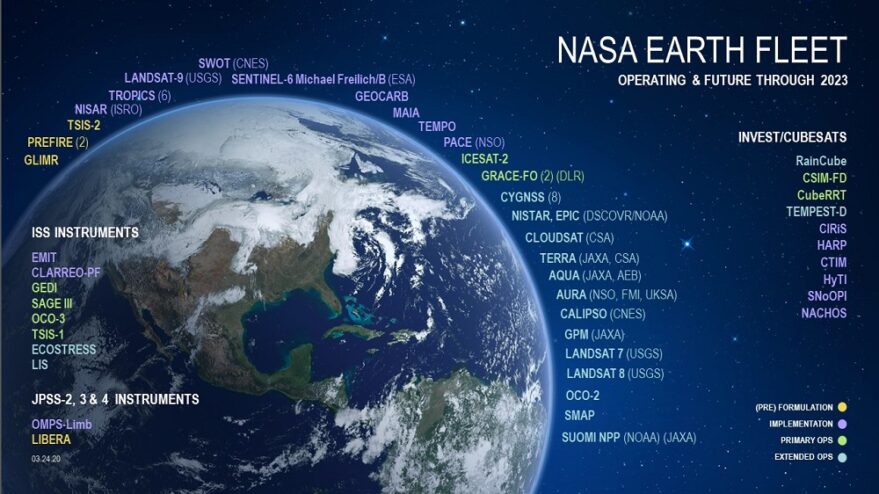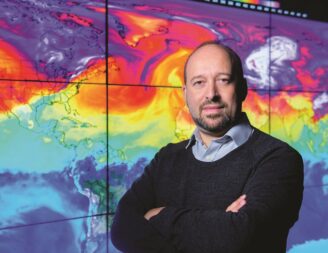“Climate change” is changing. There has been a growing push by scientists, environmental advocates and others to refer to the Earth’s changing climate as a “climate crisis” or even “climate emergency” to better reflect the severity of the problem and the urgency to take action to mitigate the worst of its effects. On April 12, for example, the venerable magazine Scientific American announced that it would now use the term “climate emergency” instead.
That urgency extends to the White House. Since taking office Jan. 20, President Joe Biden has announced a number of measures related to climate change, including an executive order titled “Tackling the Climate Crisis at Home and Abroad” and announcing that the United States would rejoin the Paris Climate Agreement. Those actions are not surprising, as the Biden campaign last year made addressing climate change one of its top overall priorities alongside the pandemic, economic recovery and racial equity.

When Biden won the election in November, many in the space industry expected — and some, perhaps, feared — NASA would shift direction, emphasizing climate change over human spaceflight. The Democratic Party’s platform had only a brief mention of space, but it included “strengthening” Earth observation programs “to better understand how climate change is impacting our home planet.”
Three months into the new administration, it’s increasingly clear those changes aren’t nearly as radical as some might have thought. There are, in statements by NASA and the White House, signs of increased emphasis on climate change research, and increased funding, but not necessarily at the expense of other science or human spaceflight programs. And, despite its expertise in Earth science research, NASA has had to struggle to gain a role in broader discussions about climate change policies.
A NEW GENERATION OF EARTH SCIENCE SATELLITES
The strongest expression of any administration’s policies is its budget. The Biden administration has been slow to roll out its fiscal year 2022 budget proposal, but finally released a budget outline for discretionary spending, which includes NASA, April 9.
That budget proposal offers NASA’s Earth science program, which received $2 billion in fiscal year 2021, an increase of $250 million, or 12.5%. The document stated that the additional funding would be used “to initiate the next generation of Earth-observing satellites to study pressing climate science questions,” but offered no other details.
That funding, though, is just a small part of the administration’s overall investment in climate change research. The budget includes more than $4 billion “to improve understanding of the changing climate and inform adaptation and resilience measures,” the proposal stated. NOAA, for example, would get an increase of about half a billion dollars to accelerate work on a new generation of weather satellites that would also provide data for studying climate change. And NASA’s overall budget rose by 6.3%, with space technology and human spaceflight also getting increases.
Neither the White House nor NASA have elaborated on how it proposed using that additional funding beyond new satellites. The widespread expectation in the Earth sciences field, though, is that the funding will allow NASA to speed up development of missions recommended by the Earth sciences decadal survey published more than three years ago.
That decadal survey recommended five “designated observables,” which are not specific mission concepts but types of measurements, from observations of aerosols in the atmosphere to hyperspectral imagery. The survey included notional costs for each of the five designated observables ranging from $300 million to $800 million.
“I don’t view this as a menu of systems you can select from. I view this as an integrated observatory, where we are looking at all the major ‘muscle movements’ of the Earth system,” said Karen St. Germain, director of NASA’s Earth science division, of those designated observables during a March 24 meeting of a National Academies committee.
She compared those proposed missions to the network of spacecraft from the Earth Observing System three decades ago. “This has the potential to be the foundation upon which two generations of scientists stand,” she said.

NASA has been working to turn those designated observables into full-fledged missions. Four of the five, she said, are nearing the “pre-Phase A” level of development, where the agency performs concept studies. The exception is one for surface deformation and change, because it will build on the NISAR synthetic aperture radar mission still under development by NASA and the Indian space agency ISRO.
A budget increase could allow NASA to move ahead with those concept studies faster, particularly those with strong climate science links. “We’re already leaping forward, I think, on that in this administration, where they’re fast-tracking some of the missions at NASA that are going to be really critical to helping us understand and become more resilient to the effects of climate change,” said Ellen Stofan, the former NASA chief scientist who led the Biden administration’s NASA transition team.
Stofan, speaking at a Georgetown University panel discussion April 12, brought up another reason to accelerate those proposed decadal missions: ensuring continuity of measurements with existing but aging Earth science missions. “When you’re trying to understand this planet, what you really need are long baselines of consistent data, so you can use that data to show that the Earth is changing,” she said.
“A number of the workhorse satellites and instruments have now been in space almost 20 years, and they’re coming to the end of their useful life,” said Gavin Schmidt, a climate scientist and director of NASA’s Goddard Institute for Space Studies in New York. “Maintaining continuity of these records is very important.”
GETTING THE WHITE HOUSE’S ATTENTION
Schmidt has taken on a new role regarding climate change studies at NASA. The agency announced Feb. 3 that he would serve, on at least an interim basis, as its first senior climate adviser.
“This position will provide NASA leadership critical insights and recommendations for the agency’s full spectrum of science, technology and infrastructure programs related to climate,” Steve Jurczyk, NASA’s acting administrator, said in a statement announcing Schmidt’s appointment. That includes promoting NASA research to study climate change, as well as work in other parts of the agency, like aeronautics, to mitigate it by reducing greenhouse gas emissions. It also involves working with the broader scientific community and with other government agencies.
“People are now asking for our advice on climate science, which they weren’t for a while,” Schmidt said during a public talk at the National Academies’ Space Science Week March 23, an indirect reference for the Trump administration’s perceived disdain for climate science. “There is, I think, a newly invigorated push from the executive branch to do more on climate across a whole swath of areas.”
He said that work goes beyond climate science research and outreach. Among other things NASA is working on are ways to reduce its own carbon footprint and making its facilities “more resilient” to the effects of climate change, such as rising sea levels and more frequent storm surges that can threaten coastal sites.
“Also, we’re being asked to make certain that the science that we do is going to the people who could use it,” he added. “We’re involved in multiple efforts to inform decision-makers or to help them make decisions based on the observations that we’re making and our analyses and models.”

But while NASA can offer its advice and insights on climate change, getting a seat at the table where policy decisions are made is more difficult. The White House, as part of that climate change executive order, established a National Climate Task Force that included more than 20 Cabinet departments and other agencies. Its job, the order stated, is to develop a whole-of-government approach to dealing with climate change.
That whole-of-government approach, though, didn’t initially involve the whole of government agencies involved in climate change. While the task force featured a wide range of agencies, such as the Department of Commerce, which includes NOAA, notably absent was NASA.
It wasn’t clear why NASA was excluded from the task force, but on March 18 the agency announced it had been added. “Given our unique ability to observe the planet from space and the long-term data records we’ve been able to assemble, NASA is in a prime position to inform policy decisions in the current administration and beyond,” Schmidt said in a statement announcing that NASA was now part of the task force.
“It wasn’t a trivial amount of work to make sure that NASA was on the climate task force,” said Bhavya Lal, NASA chief of staff, at the Georgetown University panel. “We had to call a lot of people and bend a lot of ears to convince them about NASA’s value.”
Speaking to the NASA Advisory Council’s science committee April 14, St. Germain noted that NASA’s involvement in that executive order goes beyond the task force. “NASA technologies and research, and applied science in particular, really support some of the initiatives called out in the executive order,” she said. That includes providing data and models to support climate risk analyses and studies of greenhouse gas emissions.
How the climate task force fits into the administration’s broader climate change initiative is still to be determined, an issue that goes beyond NASA. The National Science Foundation (NSF) held a call with reporters April 8 to discuss the various types of climate science it supports, from examining ice cores that show how climate changed in the past to studying the effects of ongoing climate change, such as acidification of the oceans.
“We do try and make sure that our investments are in tandem with what other agencies are thinking and doing, so that the whole is greater than the sum of the parts,” said Anjuli Bamzai, senior science adviser for global climate change at NSF.
She offered, though, few details about how that climate task force fit into those plans. “I suppose it’s being discussed at the very highest levels of the agency. We’ll have more information forthcoming,” she said. NSF, like NASA initially, was left off the task force.
Another uncertainty is how NASA might factor into the administration’s $3 trillion infrastructure plan, formally known as the American Jobs Plan. One element of that plan is supporting research and development activities, particularly in climate science. A March 31 fact sheet proposes spending $40 billion upgrading research infrastructure, including establishing a new national lab focused on climate. An additional $35 billion would go to the “full range of solutions needed to achieve technology breakthroughs that address the climate crisis.”
The document, though, doesn’t spell out how those funds might be allocated among agencies working on climate science and related technologies, beyond endorsing a major investment in NSF to create a technology directorate there. The fiscal year 2022 budget document does note that part of the $325 million proposed increase for NASA’s space technology programs would go to “novel early-stage space technology research that would support the development of clean energy.”
“NASA has, with its incoming political team, been involved in a number of discussions at various stages,” said Thomas Zurbuchen, NASA associate administrator of science, when asked by the National Academies’ Space Studies Board in March how the agency might be involved in that infrastructure plan. “Options are being discussed, but it’s way too early, I would argue, to start leaning one way or the other. We are having the right discussions.”
Those discussions take time, as does the overall process of setting policy and gaining funding, which can explain the lack of details and cautious approach NASA has been taking. (For example, St. Germain’s NASA Advisory Council science committee presentation was originally listed on the agenda as “Earth Science and the President’s Climate Agenda” before being revised in the final version to the more anodyne “Earth Science Update.”) But if this is really a climate crisis, or a climate emergency, the pace will need to speed up.
This article originally appeared in the April 19, 2021 issue of SpaceNews magazine.
